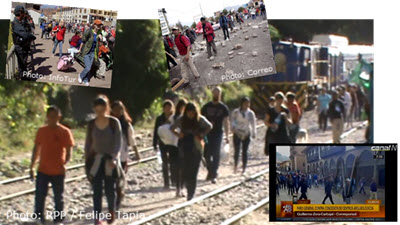By Rick Vecchio ✐
Peruvian Times Contributing Editor ☄
“There is so much more to Peru than Cusco and Machu Picchu.” How many times has that refrain found its way into print and onto the Internet?
Tell it to Cusco as it ramps up a two-day general strike to overturn Legislative Decree 1198 — a new provision to Peru’s Cultural Patrimony Law that would allow poorer, less developed regions to work with the private sector to manage, promote and conserve thousands of pre-Hispanic archaeological sites.
 Here’s the bizarre part: pretty much none of those sites are located in the ancient Inca capital. But Cusco’s political and civil establishment appears enthralled in a delusional belief that they are. They are treating the decree as a crisis of existential proportions and have taken to the streets in mass protests, demanding the repeal of 1198.
Here’s the bizarre part: pretty much none of those sites are located in the ancient Inca capital. But Cusco’s political and civil establishment appears enthralled in a delusional belief that they are. They are treating the decree as a crisis of existential proportions and have taken to the streets in mass protests, demanding the repeal of 1198.
PeruRail and Inca Rail have suspended train service to Machu Picchu for the safety of passengers. Cusco’s Public school teachers and staff were told to take the day off. Tourists landing at Velasco Astete Airport are facing road blocks between them and their hotels in the Historic Cusco Center, and the highways from Puno, Apurimac and Madre de Dios are also blocked.
Local headlines declare that the central government’s “privatization” of Cusco’s cultural patrimony would undermine the very identity of each and every Cusqueño.
“Cusco could lose 200 million soles due to a decree allowing private management of heritage sites,” one article warned, without a shred of subsequent fact to back up the baseless assertion.
That 200 million soles figure refers to all income that Cusco derives annually from tourism for its state coffers.
Far from a nefarious corporate conspiracy, Legislative Decree 1198 was inspired by the Burra Charter, a cultural heritage management road map that’s been updated every few years since it was first promulgated in 1979 in Burra, Australia, and emulated worldwide.
Peru’s branch of the International Council on Monuments and Sites (ICOMOS) has endorsed the decree and said it is eager to participate in its implementation and development.
Peru’s Ministry of Culture was given 90 days to establish a procedure for the provision, implementation and monitoring of cultural management agreements.
The Ministry of Culture issued a communique calling on the protesters to stop, take a deep breath and consider what this modification to the patrimony law truly would and would not do.
“The sole purpose of the Legislative Decree is to value our archaeological heritage, joining forces with regional and local governments, communities, universities, companies and other public and private entities that are willing to participate, if they meet the requirements,” the communique stated.
The Legislative Decree 1198 is completely optional and expressly excludes UNESCO World Heritage Sites, like the Historical Center of Cusco, Machu Picchu and all the ruins along the ancient Qhapaq Ñan system of Inca Trails, like Choquequirao, Choquecancha, and the Q’eswachaka Bridge, just to mention a few.
Every single historic destination in Cusco that collects tourist entry fees under the General Tourist Ticket Law, are also excluded, including:
- Sacsayhuaman
- Ollantaytambo
- Pisac
- Chinchero
- Pikillaqta
- Tipon
- Puka Pucara
- Tambomachay
- Moray, and a dozen other historic attractions.
Legislative Decree 1198, published Sept. 22, clearly does not transfer property rights from the state to private entities and it stipulates that any private management concession must include commitments to fund research, conservation and restoration of pre-Hispanic archaeological sites, while promoting their access and social use.
Private development of tourism would be awarded in public bidding and project concessions cannot exceed 10 years — a stipulation that would have come in handy for Cusco in its dealings with, for instance, Consettur, which has held monopolistic control over shuttle bus access to Machu Picchu for two decades.
The regional government of Cusco has long been embroiled in a legal battle to break Consettur’s questionable 30-year concession.
Peru’s Congressional Committee on Culture and Cultural Heritage in Lima is debating five bills today presented by Cusco lawmakers. Three seek outright repeal of Decree 1198 and two would superfluously exclude Cusco from the decree’s reach. Whichever bill the committee approves will then be taken up on Thursday by the full Congress.
“We want Cusco to calm down,” commission chairman Ramon Kobashigawa told Daily La Republica. He said that the majority of the committee was leaning toward exempting Cusco.
But if history is any guide, even that might not be enough to calm the hysteria.
Congress in late 2007 passed legislation sponsored by lawmaker Carlos Bruce, which sought to do basically what this decree aims to accomplish. Then, as now, Cusco rose up in opposition. So, Congressman Bruce offered an amendment exempting Cusco. But the protests in Cusco continued and intensified.
Bowing to the pressure, lawmakers ended up repealing the “Bruce Law.”
There is so much more to Peru than Cusco and Machu Picchu — amazing archaeological sites — both Inca and pre-Inca — that poorer, less developed regions want desperately to restore, conserve and share with the world, while boosting their local economies. It would be nice if this time, Cusco got out of their way.
Rick Vecchio is also director of marketing and development for Fertur Peru Travel, which is owned by his wife, Siduith Ferrer, and is a commercial sponsor of Andean Air Mail & PERUVIAN TIMES. You can read more of his articles on the Peruvian Travel Trends blog.






Unions (more likely to organize under govt employers) + politicians allied with unions in a region dependent on tourism = Decree 1198 opposition.